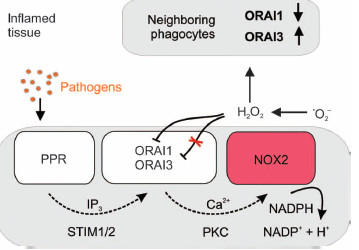AG — Prof. Heiko Rieger — Statistical Physics
A calcium-redox feedback loop controls human monocyte immune responses: The role of ORAI Ca2+ channels
Stephanie Saul, Christine S. Gibhardt, Barbara Schmidt, Annette Lis, Bastian Pasieka, David Conrad, Philipp Jung, Rosmarie Gaupp, Bodo Wonnenberg, Ebru Diler, Hedwig Stanisz, Thomas Vogt, Eva C. Schwarz, Markus Bischoff, Mathias Herrmann, Thomas Tschernig, Reinhard Kappl, Heiko Rieger, Barbara A. Niemeyer, Ivan Bogeski

Monocytes are central effector cells of the innate immune system. As professional phagocytes, they are involved in eliminating pathogens and in activating other immune cells, such as T cells. After recognizing pathogens, Ca2+ is mobilized and a rapid production of large amounts of reactive oxygen species (ROS) is initialized (Nox2–mediated “oxidative burst”). We showed that Orai channels control store-operated Ca2+ entry, ROS production, and bacterial killing in primary human monocytes. The physiological functions of human monocytes depend on both Ca2+ and redox signals [1]. Therefore, these phagocytic cells represent an ideal cellular system for examining the complex interplay between Ca2+ and ROS. With the help of a mathematical model that predicts additional features of the Ca2+ -redox interplay we identified the Orai-Nox2 feedback loop as determinant of monocyte immune response.
Preincubation with ROS prevents activation of Orai1, but is unable to inhibit the channel complex once it is activatied [1]. The inhibition is mainly mediated through the reactive cysteine C195 at the exit of transmembrane region 3 of Orai1, a residue that is not conserved in the paralouge Orai3, which currents are not inhibited. We combine experimental and theoretical approaches and show that oxidation of Orai1 leads to reduced subunit interaction, slow diffusion and that either oxidized C195 or its oxidomimetic mutaion C195D virtually eliminates channel activation by intramolecular interaction with S239.
To assess whether the observed effects are sufficient to explain the dramatic oxidant inhibition of Orai1 mediated currents, we implemented the altered diffusion and reaction rates into a modified version of the stochastic reaction diffusion model that we have previously reported [2,3]. In addition, the model was modified to introduce and account for the locked channel subunits. With this the model also allows us to predict different degrees of inhibition depending on the fraction of inhibited channels.
References
| A calcium-redox feedback loop controls human monocyte immune responses: The role of ORAI Ca2+ channels |
|
| Science Signaling 9, 1 (2016) | [pdf] |
| J. Leukoc. Biol. 88,57 - 68(2010) | |
| Biochim. Biophys. Acta, 1853,1541 – 1550(2015) | |
Related link:science_signaling_9_418_ra26_(2016)
Legal notice (Impressum) Privacy policy



